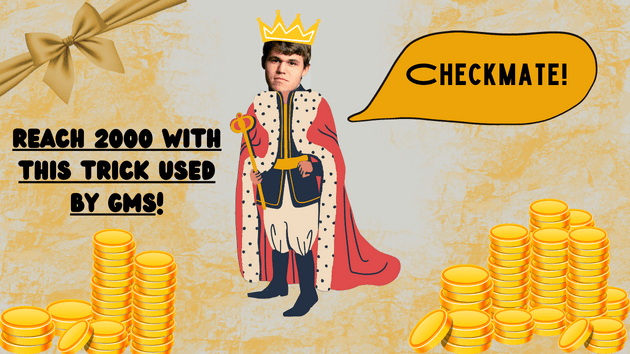
Reach 2000 with this trick used by GMs!
Reach 2000 with this trick used by GMs!
Every chess player has at least 1 time asked him-/herself how titled players do that, to blunder maximum 1 time in a game. And now you can find the answer to this important question in this article!
Analyzing a game is cheating if you use a computer but imagine you could do that yourself easily. Imagine now a game, where you blunder only 1 move or make only 1 mistake. Imagine a game, where you missed 0 brilliant moves. And now, think again on analysis. Because analysis is the key to success in chess! Every position has particularities, but a schema will help you to quickly understand the advantages, the weakness, and the possible brilliant move of the game! I know it’s not easy and you will need to train that every day (and I do that), but it’s really interesting to discover the chess game in another point of view. On my side, after having started that, I won more than 500 points on chess.com in less time!
Analysis: how do I do that?
To analyze a game, you need to compare Black and White pieces and to find the important weakness of the position for both players. For your color, you will need to make disappear this weakness, and if you find some in the opponent’s position, you will need to use them in your advantage and to show your opponent he would have better done to defend instead of attacking you!
For the analysis of a game, you will have 7 steps: Material on the board, Position of the kings, Activity of the pieces, Control of the diagonals, Control of the center, Space and Pawn structure.
1/ Material on the board:
Material is the basis of the chess game and material checking is the basis of the chess game analysis. At the beginning, you can start with a point system to do that: for example, 3 points for the Bishops and Knights, 5 points for the Rooks, 1 point for the pawns, etc.… but at titled players level, the most important is often the number of attacking pieces. That’s why my advice would be to count the number of pieces and then the number of pawns. To have for example a rook more is a clear advantage for this player!
2/ Position of the Kings:
The position of the king will change all over the game, but you ca still separate it in 2 parts: in the opening and in the middlegame, you will need to protect him, to avoid easy checkmates and to have a chance to attack yourself without being taken in a pin.
3/ Activity of the pieces:
The activity of the pieces is a fundamental of the chess analysis. If you didn’t develop your pieces or if these pieces don’t have enough squares to go or to protect, your activity decreases. Make sure you always use correctly all your pieces!
4/ Control of the diagonals:
By diagonal, I mean the squares of the two main diagonals that are a1-h8 and a8-h1. These two diagonals do include the squares e4, e5, d4 and d5. By taking these diagonals with for example your bishops in fianchetto, you control indirectly the center too! If your opponent does control both, you can say he has an advantage and you have a big problem!
5/ Control of the center:
The center is composed of the squares e4, e5, d4 and d5. These four cases are in the middle of the board and need to be controlled or you won’t have the possibility anymore to develop you pieces correctly, which means that you cannot either defend or attack! Take care that you first control at least one part before starting any tactic that is not sure to work!
6/ Space:
It’s important to have territory on the board. This objective can be achieved easily by advancing your pawns. But you cannot just advance them and think you have won the game! Take care that your pieces (for example your knights) have enough cases too to start an attack and not to be blocked if the opponent’s pawns do start to advance and to attack your minor pieces.
7/ Pawn structure:
This seventh and last point is probably the most important: each player does have 8 points at the beginning that he need to place on the board, on 8 different columns (normally if they have been no exchanges between both players). These pawns need to take control of the board and to block the opponent’s pieces, but need to be protected too, because in an endgame, if you have 1 passed pawn more, you can be sure to win material or to promote it to a queen!
Conclusion:
First, congratulations for having read this article entirely! I hope you will use these seven steps of analysis in your future games! Moreover, you see that it’s important to follow not only one but many more chess basic ideas to find the best moves and to have the possibility to play brilliant moves and tactics in your games. If you have more questions about this, feel free to ask them in the comments of this article. Furthermore, you can follow this blog or send me a friend request if you want to know when my next article is published.
Have a good day, and good luck for your future games by analyzing your positions!
@Kyu13
More blogs written by @Kyu13:
The main question: How to become a stronger player?
The Scotch Game: A good opening?
Puzzle Road:
[Puzzle Road] Attack, Block and Take! (P1)
[Puzzle Road] Check the king for a good promotion! (P2)
[Puzzle Road] Bishops vs. Pawns: fight for a draw! (P3)
[Puzzle Road] Go out of my way! (P4)


